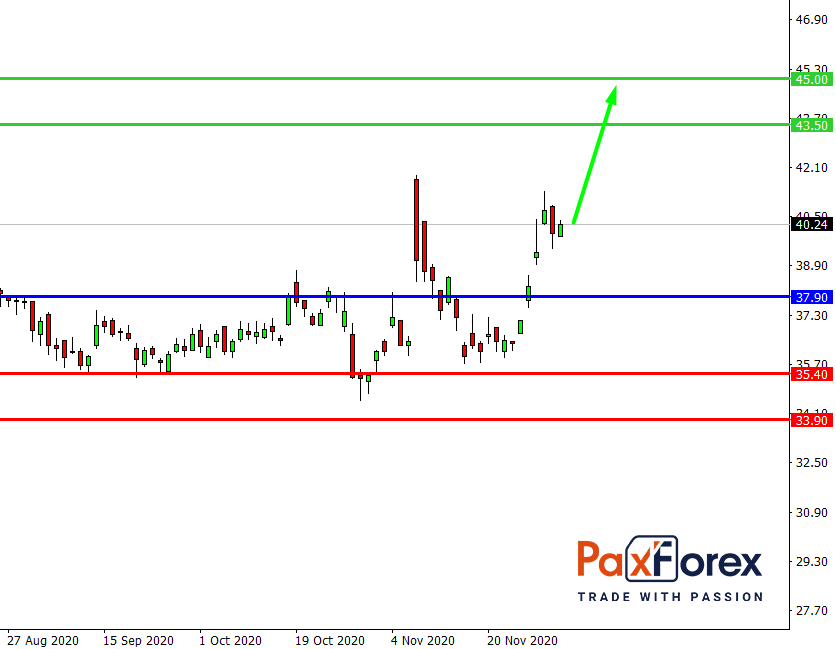
Source: PaxForex Premium Analytics Portal, Fundamental Insight
Today there is a lot of excitement around Pfizer and the COVID-19 vaccine it is working on together with BioNTech. The vaccine is more than 90% effective against COVID-19. No doubt, the company has a strong business that brings solid, stable results over many years, in addition to its success in vaccine development.
To be a good dividend company, Pfizer must not only pay more than the average S&P 500 shares but also be stable, which is likely to be for many years. Let's see how Pfizer's dividends compare to these criteria. Investors who buy Pfizer shares today will earn $0.38 every quarter. Annually, this amounts to $1.52. And when trading shares at the level of about $41, this means an annual return of 3.7%. Currently, a typical S&P 500 share has an average dividend yield of 1.8%, which is a benchmark that Pfizer has now significantly outperformed.
This difference can bring a lot of money. If you invested $25,000 in Pfizer, you could earn $925 in annual dividend income. With an average S&P 500 stock, you would only earn $450 - $475 less than if you had invested in the best healthcare stocks.
But a good payout doesn't mean much if the company can't afford to keep paying it. Next, let's see how safe Pfizer's dividends are.
For Pfizer to be able to continue paying out dividends, it has to be profitable and make enough money. On October 27, the company reported profits for the third quarter. It reported earnings per share (EPS) of $0.39, just above its quarterly dividend per share. This year, however, the pandemic has harmed Pfizer's business, as hospitals are postponing medical procedures and regular medical care is being relegated to the sidelines as doctors focus on COVID-19. A year ago, Pfizer's earnings per share were $1.36 in the third quarter and left enough room for dividends.
A more important indicator, however, is how Pfizer works in terms of cash flow. In the first nine months of this year, the company raised $8.8 billion in cash from its daily operations, which is close to the same amount received a year ago. Having spent $1.5 billion this year on installations, fixed assets, its free cash flow of $7.3 billion exceeds the $6.3 billion it has paid in dividends to date. In terms of both cash and income, Pfizer's dividends look good.
However, in order to really be a good dividend asset, investors must also expect it to grow in value. Otherwise, inflation will slowly reduce what you actually make of stocks over the years.
Five years ago Pfizer paid a quarterly dividend of $0.28, and since then the company has increased its payments by 35.7%, which averaged 6.3% per annum. Pfizer has been increasing its dividend payments since 2010. This means that a company that has been increasing its dividend payments for 25 or 30 consecutive years will have more incentives to continue to grow its payments and continue to do so than a company that has only increased its payments for 11 consecutive years.
Pfizer last announced a dividend increase in December 2019. However, given that the business is going well and Pfizer has ample opportunity to further increase its dividends, there is a possibility that their growth will continue in the foreseeable future.
Pfizer's dividends fall into all the boxes of what investors are likely to look for in stocks with large dividends. There may be fears that with its Upjohn business (which accounted for 17% of Pfizer's sales for the year to date), which should merge with Mylan, Pfizer will see a decline next year. However, this will not necessarily hurt the bottom line, as the Upjohn business accounted for only 14% of the segment's total profit in 2020 and also fell by more than 40% compared to the previous year.
Overall, Pfizer's business still looks good and it is more than an excellent investment.

While the price is above 37.90, follow the recommendations below:
- Time frame: D1
- Recommendation: long position
- Entry point: 40.34
- Take Profit 1: 43.50
- Take Profit 2: 45.00
Alternative scenario:
If the level 37.90 is broken-down, follow the recommendations below;
- Time frame: D1
- Recommendation: short position
- Entry point: 37.90
- Take Profit 1: 35.40
- Take Profit 2: 33.90













